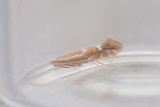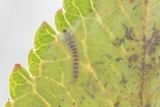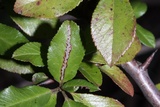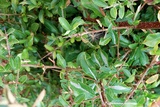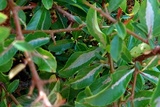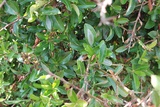Phyllonorycter leucographella (Zeller, 1850) Species
Last modified: Nov. 26, 2024, 12:57 p.m.
This species arrived in 1993 in Belgium, continuously spreading, mainly via gardens and parks in which the larval hostplant is planted as an ornamental plant. Present in all provinces.
Details
- Classification
- Family: Gracillariidae > Subfamily: Lithocolletinae > Genus: Phyllonorycter > Species: Phyllonorycter leucographella
- Vernacular names
- Vuurdoornvouwmot (NL), Firethorn leaf-miner (EN), Feuerdornminiermotte (DE)
- First mention in Belgium
- De Prins W. 1994. Phyllonorycter leucographella (Zeller, 1850), een nieuwe soort voor de Belgische fauna (Lepidoptera: Gracillariidae). — Phegea 22(4): 125–128. On page 125. view page
- Status
-
Native
Distribution
Imago
Head ochreous, mixed with some white hairs. The forewing ground color is golden brown, white pattern consisting of a narrow, rather long basal line (almost reaching the middle of the wing), a row of scales at the base at the dorsum, four costal and three dorsal striae (the most basal of the dorsal striae very narrow and long, the most distal of these striae very small), all striae finely edged with brown scales.
Caterpillar
The species does not go into diapause and thus has permanent caterpillars. The first instars are yellow with on the dorsum of each thoracical and abdominal segment a dark brown or blackish patch. Head capsule dark brown or black. Later instars are completely yellow, of a somewhat warmer hue, and without any pattern.
Mine
The leaf mines can be found all year round. At first a short serpentine mine at the upper side of the leaf, gradually broadening until it becomes a large, whitish tentiform mine. In the beginning, the brownish frass is concentrated along or on the main vein, but later on, it is spread all over the mine as light brown patches. There are no brownish or black dots like in Phyllonorycter corylifoliella. Also, Ph. leucographella does not make an inner mine like Phyllonorycter corylifoliella does. In the last stage the mine covers the whole leaf area and the leaf is folded longitudinally concealing the mine completely.
See also gracillariidae.net and bladmineerders.be.
Bionomics
One egg is oviposited at the base of a leaf, on the upperside of the main vein. The species hibernates in the larval stage, with the leaves attached to the plant. Pupation during spring.
This species can sometimes heavily be parasitized as was experienced in a garden near Antwerpen where 100% of the collected mines (n=200) were parasitized by an eulophid species.
Flight periods
It is not clear how many generations per year are produced. The adults have been observed from April till October.
Observed on
- Host plant (species):
- Pyracantha coccinea
The larva lives on Pyracantha coccinea, but occasionally, when population density is really high and almost every leaf of its primary host plant is infested, it can also survive on other Rosaceae, like Chaenomeles, Cotoneaster, Cydonia, Malus or Sorbus.
Habitat
Parks and gardens were Pyracantha coccinea is planted as an ornamental plant.
